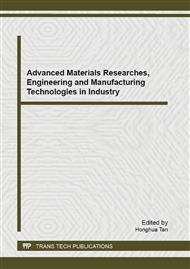[1]
Ling HI, Leshchinsky D, Tatsuoka F. Reinforced soil engineering: advances in research and practice: CRC; (2003).
Google Scholar
[2]
Jones R. Mechanics of composite materials: CRC; (1998).
Google Scholar
[3]
Kazemian S, Huat B, Prasad A, Barghchi M. A review of stabilization of soft soils by injection of chemical grouting. Australian J Basic Appl Sci. 2010; 4(12): 5862-8.
Google Scholar
[4]
Abtahi SM, Ebrahimi MG, Kunt MM, Hejazi SM, Esfandiarpour S. Production of Polypropylene-reinforced Asphalt Concrete Mixtures Based on Dry Procedure and Superpave Gyratory Compactor. Iranian Polymer Journal. 2011; 20(10): 813-23.
Google Scholar
[5]
Consoli NC, Casagrande MDT, Prietto PDM, Thomé A. Plate load test on fiber-reinforced soil. Journal of geotechnical and geoenvironmental engineering. 2003; 129(10): 951-5.
DOI: 10.1061/(asce)1090-0241(2003)129:10(951)
Google Scholar
[6]
Consoli NC, Vendruscolo MA, Fonini A, Rosa FD. Fiber reinforcement effects on sand considering a wide cementation range. Geotextiles and Geomembranes. 2009; 27(3): 196-203.
DOI: 10.1016/j.geotexmem.2008.11.005
Google Scholar
[7]
Diambra A, Ibraim E, Muir Wood D, Russell A. Fibre reinforced sands: Experiments and modelling. Geotextiles and Geomembranes. 2010; 28(3): 238-50.
DOI: 10.1016/j.geotexmem.2009.09.010
Google Scholar
[8]
Freilich B, Li C, Zornberg J. Effective shear strength of fiber-reinforced clays. 9th International Conference on Geosynthetics, Brazil2010. p.1997-(2000).
Google Scholar
[9]
Ghazavi M, Roustaie M. The influence of freeze–thaw cycles on the unconfined compressive strength of fiber-reinforced clay. Cold Regions Science and Technology. 2010; 61(2): 125-31.
DOI: 10.1016/j.coldregions.2009.12.005
Google Scholar
[10]
Kaniraj SR, Havanagi VG. Behavior of cement-stabilized fiber-reinforced fly ash-soil mixtures. Journal of geotechnical and geoenvironmental engineering. 2001; 127(7): 574-84.
DOI: 10.1061/(asce)1090-0241(2001)127:7(574)
Google Scholar
[11]
Latha GM, Murthy VS. Effects of reinforcement form on the behavior of geosynthetic reinforced sand. Geotextiles and Geomembranes. 2007; 25(1): 23-32.
DOI: 10.1016/j.geotexmem.2006.09.002
Google Scholar
[12]
Park SS. Effect of fiber reinforcement and distribution on unconfined compressive strength of fiber-reinforced cemented sand. Geotextiles and Geomembranes. 2009; 27(2): 162-6.
DOI: 10.1016/j.geotexmem.2008.09.001
Google Scholar
[13]
Park SS. Unconfined compressive strength and ductility of fiber-reinforced cemented sand. Construction and Building Materials. 2011; 25(2): 1134-8.
DOI: 10.1016/j.conbuildmat.2010.07.017
Google Scholar
[14]
Prabakar J, Sridhar R. Effect of random inclusion of sisal fibre on strength behaviour of soil. Construction and Building Materials. 2002; 16(2): 123-31.
DOI: 10.1016/s0950-0618(02)00008-9
Google Scholar
[15]
Ranjan G, Vasan R, Charan H. Probabilistic analysis of randomly distributed fiber-reinforced soil. Journal of Geotechnical Engineering. 1996; 122(6): 419-26.
DOI: 10.1061/(asce)0733-9410(1996)122:6(419)
Google Scholar
[16]
Santoni RL, Webster SL. Airfields and roads construction using fiber stabilization of sands. Journal of transportation engineering. 2001; 127(2): 96-104.
DOI: 10.1061/(asce)0733-947x(2001)127:2(96)
Google Scholar
[17]
Tang C, Shi B, Gao W, Chen F, Cai Y. Strength and mechanical behavior of short polypropylene fiber reinforced and cement stabilized clayey soil. Geotextiles and Geomembranes. 2007; 25(3): 194-202.
DOI: 10.1016/j.geotexmem.2006.11.002
Google Scholar
[18]
Tang CS, Shi B, Zhao LZ. Interfacial shear strength of fiber reinforced soil. Geotextiles and Geomembranes. 2010; 28(1): 54-62.
DOI: 10.1016/j.geotexmem.2009.10.001
Google Scholar
[19]
Yetimoglu T, Inanir M, Esat Inanir O. A study on bearing capacity of randomly distributed fiber-reinforced sand fills overlying soft clay. Geotextiles and Geomembranes. 2005; 23(2): 174-83.
DOI: 10.1016/j.geotexmem.2004.09.004
Google Scholar
[20]
Yetimoglu T, Salbas O. A study on shear strength of sands reinforced with randomly distributed discrete fibers. Geotextiles and Geomembranes. 2003; 21(2): 103-10.
DOI: 10.1016/s0266-1144(03)00003-7
Google Scholar
[21]
Leflaive E. Soils reinforced with continuous yarns: the Texol. Proc 11th Intl Conf On Soil Mech and Foundation Eng, San Francisco1985. pp.1787-90.
Google Scholar
[22]
Becker EB, Folliard KJ, Gilbert RB, Rathje EM. Mechanical response of fiber-reinforced soil. (2005).
Google Scholar
[23]
Khattak MJ, Alrashidi M. Durability and mechanistic characteristics of fiber reinforced soil–cement mixtures. The International Journal of Pavement Engineering. 2006; 7(1): 53-62.
DOI: 10.1080/10298430500489207
Google Scholar
[24]
Viswanadham B, Phanikumar B, Mukherjee RV. Swelling behaviour of a geofiber-reinforced expansive soil. Geotextiles and Geomembranes. 2009; 27(1): 73-6.
DOI: 10.1016/j.geotexmem.2008.06.002
Google Scholar
[25]
Abtahi M, Ebadi F, Hejazi M, Sheikhzadeh M. On the use of textile fibers to achieve mechanical soil stabilization. 4th International Textile, Clothing & Design Conference2008. p.115.
Google Scholar
[26]
Jamshidi R, Towhata I, Ghiassian H, Tabarsa A. Experimental evaluation of dynamic deformation characteristics of sheet pile retaining walls with fiber reinforced backfill. Soil Dynamics and Earthquake Engineering. 2010; 30(6): 438-46.
DOI: 10.1016/j.soildyn.2009.12.017
Google Scholar
[27]
Puppala AJ, Musenda C. Effects of fiber reinforcement on strength and volume change in expansive soils. Transportation Research Record: Journal of the Transportation Research Board. 2000; 1736(-1): 134-40.
DOI: 10.3141/1736-17
Google Scholar
[28]
Vasudev D. Performance studies on rigid pavement sections built on stabilized sulfate soils. (2007).
DOI: 10.1061/40913(232)10
Google Scholar
[29]
Marandi S, Bagheripour M, Rahgozar R, Zare H. Strength and ductility of randomly distributed palm fibers reinforced silty-sand soils. American Journal of Applied Sciences. 2008; 5(3): 209-20.
DOI: 10.3844/ajassp.2008.209.220
Google Scholar
[30]
Santoni RL, Tingle JS, Webster SL. Engineering properties of sand-fiber mixtures for road construction. Journal of geotechnical and geoenvironmental engineering. 2001; 127(3): 258-68.
DOI: 10.1061/(asce)1090-0241(2001)127:3(258)
Google Scholar
[31]
Punthutaecha K, Puppala AJ, Vanapalli SK, Inyang H. Volume change behaviors of expansive soils stabilized with recycled ashes and fibers. Journal of materials in civil engineering. 2006; 18(2): 295-306.
DOI: 10.1061/(asce)0899-1561(2006)18:2(295)
Google Scholar


